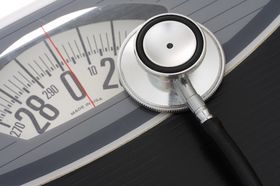Healthy weight loss! Here’s how
Scientific support: Theresa Kössler
When it comes to losing weight, your own well-being – not the perfect bikini body or other external factors – should be the No. 1 concern. Having a healthy body weight can prevent many types of disease, especially type 2 diabetes.
Healthy weight loss means changing how you live – forever! In contrast, crash diets result in the yo-yo effect and pose a risk to health.

The question “do I need to lose weight?” can be answered in part using the body mass index (BMI).
The body mass index (BMI) describes the relationship between body weight and height.
BMI is a guideline value used to determine whether someone is overweight or not. The following categories are used, although age also plays a role:
- Underweight: Less than 18.5 kg/m²
- Normal weight (optimal weight): 18.5 to 24.9 kg/m²
- Overweight: 25 to 29.9 kg/m²
A BMI of 30 kg/m² or above indicates obesity (adiposity). Because BMI does not distinguish between fat and muscle mass, it cannot be used as an indicator of fat mass in athletes with high levels of muscle mass, for example.
BMI is calculated as follows:
BMI = Body weight in kilograms : Height in meters squared
The following people would benefit from weight loss:
- Obese people with a BMI of 30 kg/m² or above. They are considered severely overweight.
- People with a BMI of between 25 and 30 kg/m² and who have other diseases, such as high blood pressure and prediabetes.
- Women with a waist circumference of more than 88 centimeters and men with a waist circumference of more than 102 centimeters.
How does weight loss actually work?
More energy must be used than is consumed in order to lose weight. A permanent change in diet is crucial, as is supplying the body with the important nutrients it needs. No “miracle diet” exists – despite all the claims made in advertisements.
It is better to set realistic goals and to start small. After seeing the initial successes, the goals can then be adjusted.
Even a 5 to 10 percent loss in body weight will have a positive effect on health. The aim should be to lose 1 to 2 kilograms per month.
Good to know:
A woman measuring 160 centimeters and weighing 80 kilograms should lose between 4 and 8 kilograms. This corresponds to 5 to 10 percent of her initial weight.
These 3 pillars should always be taken into account: Diet, exercise, and your own behavior.
The diet should provide about 500 kilocalories (kcal, often referred to as “calories”) less energy per day than is actually needed. This corresponds to an approximate weight loss of 1 to 2 kilograms per month.
Regardless of whether only carbohydrates, only fats, or fats and sugar are cut back to reduce the energy intake, according to studies, all strategies have the same degree of success. The important thing is to choose a diet that suits you and is sustainable in the long term. Of course, a few little exceptions here and there are allowed.
Find out here what a balanced diet looks like!
What is the daily individual energy requirement? This depends, among other things, on how active you are, how tall you are, your gender and your age. It can also be measured or calculated using other methods. It is best to seek advice from a doctor or nutritionist.
Physical activity is a key component of weight loss. It should be at least 150 minutes per week. This can improve both personal well-being and fitness levels.
Tips for the best way to get started and be more active are compiled here!
A general rethinking of lifestyle habits is necessary. There are numerous ways to incorporate more physical activity into daily life. Taking the stairs more often or going for a relaxing walk in the evening are just two examples.
Practical dietary recommendations
(Gallery based on the recommendation contained in the patient diagnosis and treatment guidelines Obesity)
Taking time to eat and consciously enjoying food makes you more aware of your own feelings of hunger and fullness. A food diary enables you to better assess your eating and drinking habits and identify unnecessary calories. Talk to a nutritionist about keeping a food diary.
First of all, it is great that you have already achieved some success. It is totally normal for weight loss to be rapid during the first few weeks and then begin to slow. When losing weight, the body loses both fat and muscle. This reduces the daily energy requirement. To continue losing weight, it is necessary to further reduce the kilocalorie intake and do more exercise. After all, physical activity helps the body gain more muscle and, in turn, increases energy use.
Important: Be patient. Don’t go from one extreme to another and maintain the lifestyle changes. Better to lose of few kilos in the long term than risk suffering from the yo-yo effect!
No! To lose weight and maintain the new weight, slow weight loss and sustained lifestyle changes are essential.
Crash diets and one-sided diets can lead to nutrient deficiencies and usually result in the yo-yo effect with the body weight rapidly being greater than before.
The body tries to maintain its weight – a survival strategy from the time when food was scarce. During phases of hunger, the body reduces its energy use and during times of abundance it stores energy in the form of fat.
Therefore, over a few weeks, a crash diet can result in significant weight loss. However, directly afterwards, only slightly higher energy intake than during the diet is enough to begin to gain weight.
The yo-yo effect is not only frustrating but can also be dangerous to health. The regained fat is increasingly stored in the abdominal region, raising the risk of type 2 diabetes and cardiovascular diseases.
It literally has to be stopped in its tracks. Reducing the speed means: Slow weight loss and permanent lifestyle changes.
This requires a balanced diet plan that suits your individual preferences and that can be adhered to in the long term. Regular physical activity is the key component for success, even after the target body weight has been achieved.
Suffering some setbacks and obstacles is normal. Don’t get discouraged and fall back into old patterns of behavior. Regularly checking your weight and seeking contact with people in the same situation can help. It is especially good to discover new recipes that are both tasty and healthy or find a new active hobby. Regular visits to a physician or nutritionist can help you to maintain your new lifestyle. If weight loss is necessary for medical reasons, and prescribed by a doctor, health insurance providers will pay at least a part of the cost for nutritional advice.
Suffering a drop in motivation? Find tips and tricks in our motivation section!
Sources:
Bangalore, S. et al.: Body-Weight Fluctuations and Outcomes in Coronary Disease. In: N Engl J Med, 2017, 376: 1332-1340
Deutsches Institut für Medizinische Dokumentation und Information: Wirksamkeit von Diäten zur nachhaltigen Gewichtsreduktion bei Übergewicht und Adipositas. HTA-Bericht 127. 1 Auflage. 2013
Holzapfel, C. et al.: Gewichtserhaltung nach Gewichtsreduktion – wie der Körper sein Gewicht verteidigt. In: Dtsch med Wochenschr, 2011, 136: 89-94
SRH Hochschule für Gesundheit et al.: Patientenleitlinie zur Diagnose und Behandlung der Adipositas. 1. Auflage. 2019
Weck, M. et al.: Wie ist Gewichtsreduktion erfolgreich möglich? In: Dtsch med Wochenschr, 2012, 137: 2223-2228
As of: 13.10.2021


















